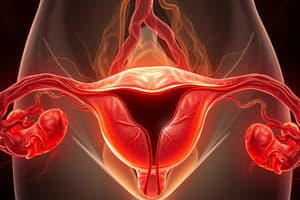Podcast
Questions and Answers
What is the typical success rate for Uterine Artery Ligation (UAL)?
What is the typical success rate for Uterine Artery Ligation (UAL)?
The Shock Index (SI) is calculated by dividing the systolic BP by heart rate.
The Shock Index (SI) is calculated by dividing the systolic BP by heart rate.
False (B)
What should be done if the Shock Index (SI) is greater than or equal to 0.9?
What should be done if the Shock Index (SI) is greater than or equal to 0.9?
Blood transfusion is indicated.
The packing of the uterus is considered an ______ method for management of PPH.
The packing of the uterus is considered an ______ method for management of PPH.
Signup and view all the answers
Match the medical terms with their descriptions:
Match the medical terms with their descriptions:
Signup and view all the answers
Which of the following is NOT a maternal risk factor for postpartum hemorrhage (PPH)?
Which of the following is NOT a maternal risk factor for postpartum hemorrhage (PPH)?
Signup and view all the answers
Obesity is a risk factor that contributes to an increased likelihood of postpartum hemorrhage.
Obesity is a risk factor that contributes to an increased likelihood of postpartum hemorrhage.
Signup and view all the answers
What is the first step in the resuscitation management of postpartum hemorrhage?
What is the first step in the resuscitation management of postpartum hemorrhage?
Signup and view all the answers
A uterus that is well-contracted is indicative of __________ PPH.
A uterus that is well-contracted is indicative of __________ PPH.
Signup and view all the answers
Match the following uterine tone conditions with their corresponding PPH indication:
Match the following uterine tone conditions with their corresponding PPH indication:
Signup and view all the answers
How often should uterine tone be monitored during the fourth stage of labor?
How often should uterine tone be monitored during the fourth stage of labor?
Signup and view all the answers
Perineal tears are a possible complication during the fourth stage of labor.
Perineal tears are a possible complication during the fourth stage of labor.
Signup and view all the answers
What should the patient be advised to do regarding urination after delivery?
What should the patient be advised to do regarding urination after delivery?
Signup and view all the answers
The mother's body may experience __________ after the delivery of the placenta.
The mother's body may experience __________ after the delivery of the placenta.
Signup and view all the answers
Match the following complications with their descriptions:
Match the following complications with their descriptions:
Signup and view all the answers
What is the maximum time allowed for the placenta to be delivered after the baby for it to be considered retained?
What is the maximum time allowed for the placenta to be delivered after the baby for it to be considered retained?
Signup and view all the answers
Manual removal of the placenta is only performed under general anesthesia (GA).
Manual removal of the placenta is only performed under general anesthesia (GA).
Signup and view all the answers
What is the primary management approach for a placenta that separates from the uterus but is not expelled?
What is the primary management approach for a placenta that separates from the uterus but is not expelled?
Signup and view all the answers
The placenta accreta spectrum typically requires a __________ for management.
The placenta accreta spectrum typically requires a __________ for management.
Signup and view all the answers
What is a major side effect of methylergometrine?
What is a major side effect of methylergometrine?
Signup and view all the answers
Match each cause of retained placenta with its appropriate management:
Match each cause of retained placenta with its appropriate management:
Signup and view all the answers
Syntometrine is a combination of oxytocin and methylergometrine that is readily available and inexpensive.
Syntometrine is a combination of oxytocin and methylergometrine that is readily available and inexpensive.
Signup and view all the answers
What is the maximum dose of Carboprost for the management of PPH?
What is the maximum dose of Carboprost for the management of PPH?
Signup and view all the answers
Misoprostol is contraindicated in patients with a ________ uterus due to history of rupture.
Misoprostol is contraindicated in patients with a ________ uterus due to history of rupture.
Signup and view all the answers
Match the drugs with their specific characteristics or warnings:
Match the drugs with their specific characteristics or warnings:
Signup and view all the answers
What is considered primary postpartum hemorrhage?
What is considered primary postpartum hemorrhage?
Signup and view all the answers
Retention of placental tissue is one of the causes of secondary postpartum hemorrhage.
Retention of placental tissue is one of the causes of secondary postpartum hemorrhage.
Signup and view all the answers
What is the best method to prevent postpartum hemorrhage?
What is the best method to prevent postpartum hemorrhage?
Signup and view all the answers
The acronym 4Ts stands for Tone, Trauma, Thrombin, and _____ in relation to postpartum hemorrhage causes.
The acronym 4Ts stands for Tone, Trauma, Thrombin, and _____ in relation to postpartum hemorrhage causes.
Signup and view all the answers
Match the types of postpartum hemorrhage with their characteristics:
Match the types of postpartum hemorrhage with their characteristics:
Signup and view all the answers
What should be done first when signs of placental separation are observed?
What should be done first when signs of placental separation are observed?
Signup and view all the answers
Controlled cord traction can be performed by anyone.
Controlled cord traction can be performed by anyone.
Signup and view all the answers
What is the time frame for intermittent assessment of uterine tone after placenta delivery?
What is the time frame for intermittent assessment of uterine tone after placenta delivery?
Signup and view all the answers
If the placenta is not delivered within __ minutes after the baby is born, it is considered a prolonged third stage.
If the placenta is not delivered within __ minutes after the baby is born, it is considered a prolonged third stage.
Signup and view all the answers
Match the following scenarios with their corresponding actions:
Match the following scenarios with their corresponding actions:
Signup and view all the answers
What is the primary purpose of delayed cord clamping in newborns?
What is the primary purpose of delayed cord clamping in newborns?
Signup and view all the answers
Dinoprostone (PGE2) is recommended by WHO for the management of postpartum hemorrhage (PPH).
Dinoprostone (PGE2) is recommended by WHO for the management of postpartum hemorrhage (PPH).
Signup and view all the answers
What should be administered if there is an increased risk for postpartum hemorrhage (PPH)?
What should be administered if there is an increased risk for postpartum hemorrhage (PPH)?
Signup and view all the answers
Clamping of the cord should be delayed for at least __________ after birth.
Clamping of the cord should be delayed for at least __________ after birth.
Signup and view all the answers
Match the conditions with their corresponding guidelines for delayed cord clamping:
Match the conditions with their corresponding guidelines for delayed cord clamping:
Signup and view all the answers
Which drug is recommended by WHO as the first line for managing postpartum hemorrhage?
Which drug is recommended by WHO as the first line for managing postpartum hemorrhage?
Signup and view all the answers
Compression sutures are only used in stable patients.
Compression sutures are only used in stable patients.
Signup and view all the answers
What is the maximum capacity of the Bakri Balloon Catheter?
What is the maximum capacity of the Bakri Balloon Catheter?
Signup and view all the answers
If bleeding continues and the patient's vitals are unstable, one of the options is to perform a __________ hysterectomy.
If bleeding continues and the patient's vitals are unstable, one of the options is to perform a __________ hysterectomy.
Signup and view all the answers
Match the following compression suture types with their common abbreviations:
Match the following compression suture types with their common abbreviations:
Signup and view all the answers
What is the primary effect of oxytocin when administered during postpartum hemorrhage?
What is the primary effect of oxytocin when administered during postpartum hemorrhage?
Signup and view all the answers
Injecting tranexamic acid is recommended to be done within 5 hours of the onset of postpartum hemorrhage.
Injecting tranexamic acid is recommended to be done within 5 hours of the onset of postpartum hemorrhage.
Signup and view all the answers
What is the recommended intravenous dose of tranexamic acid for managing postpartum hemorrhage?
What is the recommended intravenous dose of tranexamic acid for managing postpartum hemorrhage?
Signup and view all the answers
Oxytocin has a duration of action of ________.
Oxytocin has a duration of action of ________.
Signup and view all the answers
Match the types of uterotonic drugs with their characteristics:
Match the types of uterotonic drugs with their characteristics:
Signup and view all the answers
Which of the following is NOT a consideration when administering uterotonic drugs?
Which of the following is NOT a consideration when administering uterotonic drugs?
Signup and view all the answers
Hypotension may reappear within 12 hours after administering tranexamic acid.
Hypotension may reappear within 12 hours after administering tranexamic acid.
Signup and view all the answers
What is one important reason to avoid IV bolus injections of uterotonic agents?
What is one important reason to avoid IV bolus injections of uterotonic agents?
Signup and view all the answers
Study Notes
Uterine Artery Ligation (UAL)
- Performed at the site where the broad ligament turns upwards, where the round ligament crosses.
- Maintained in close proximity to the uterus to prevent ureter injury.
- Success rate for bilateral UAL is 85%.
Ovarian Artery
- Suturing includes part of the myometrium to prevent slipping.
Shock Index (SI)
- Calculated by dividing heart rate by systolic blood pressure.
- Normal SI is between 0.5 and 0.7.
- SI ≥ 0.9 indicates a need for blood transfusion and increased risk of maternal mortality.
Postpartum Hemorrhage (PPH)
- Defined as blood loss ≥ 500 mL after vaginal delivery, or ≥ 1000 mL after a C-section.
- ACOG defines it as blood loss ≥ 1000 mL after any type of delivery.
- Classified as primary (within 24 hours) or secondary (24 hours to 12 weeks).
- Common causes include:
- Tone: Atonic uterus (most common).
- Trauma: Perineal or cervical tears, hematomas, uterine ruptures.
- Thrombin: Bleeding issues (disorders).
- Tissue: Retained placental tissue (common secondary PPH cause).
Fourth Stage of Labour
- Monitored for 1-2 hours after placenta delivery.
- Vital signs monitored for postpartum hemorrhage.
- Common complications include postpartum hemorrhage, perineal tears, and vulval hematomas.
Complications of Third Stage of Labour
- Retained Placenta:
- Failure of placenta to deliver within 30 minutes of baby delivery.
- Management depends on the cause:
- Oxytocin + Controlled Cord Traction (CCT): for placenta separated but not expelled.
- Manual removal of placenta under general anesthesia (GA): for placenta attached but not invading myometrium or for morbidly adherent placenta.
- Hysterectomy: for placenta accreta spectrum.
Management of PPH
- Resuscitation:
- Large-bore IV cannula insertion.
- Blood samples for ABO/Rh grouping, CBC, BT, CT, etc.
- Blood transfusion arrangements.
- Crystalloids (e.g., 1000 mL/min of Ringer's lactate or normal saline).
- Monitoring of airway, breathing, and circulation.
- Foley's catheter insertion.
- Uterine Tone:
- A normal tone indicates a traumatic PPH and requires a pelvic examination to determine the cause.
- A decreased tone indicates an atonic PPH and requires a pelvic examination to rule out retained membranes/placental parts.
Methylergometrine
- Causes tetanic contractions in the uterus.
- Not suitable during pregnancy.
- Can lead to retained placenta.
- Dose: 0.2mg IM, repeated in 2-4 hours.
- IV administration avoided due to sudden BP spikes.
- Side effect: Hypertension.
Syntometrine
- Fixed-dose combination of oxytocin and 0.5mg methylergometrine.
- More expensive and not readily available.
Misoprostol
- PGE₂ uterotonic in tablet form.
- WHO recommends antenatal distribution in rural areas to prevent PPH.
- Sublingual/oral/per-rectal administration.
- Side effects: Hyperthermia, shivering, nausea, vomiting, and can cause uterine rupture.
Carboprosts/Dinoprost/Hemabate
- PGF₂α, gold standard for managing PPH.
- Dose: 250mcg IM every 15-40 minutes, maximum 8 doses.
- Side effect: Diarrhea.
- Contraindications: Asthma, pulmonary hypertension, suspected amniotic fluid embolism, and PIH.
Active Management Of Third Stage Of Labour (AMTSL)
- Steps include:
- Uterotonic drug administration (oxytocin is the first-line drug).
- Delayed cord clamping.
- Controlled cord traction.
- Intermittent assessment of uterine tone.
Management of Atonic PPH
- Requires three simultaneous steps:
- Bimanual uterine massage.
- Injection of Tranexamic acid.
- Uterotonic drug administration.
Tranexamic Acid
- Administration: Within 3 hours of PPH onset.
- Dose: 1g in 100ml of normal saline intravenously over 20 minutes.
- Important Considerations:
- Rapid administration can cause hypotension.
- Dose should be repeated if bleeding persists.
- Hypotension may last for 30 minutes or more and reappear within 12 hours.
Oxytocin
- First-line drug recommended by the WHO for uterine contraction.
- Dose: 20-40 IU intravenously or intramuscularly via infusion.
- Important Considerations:
- Avoid IV bolus due to increased risk of hypotension, arrhythmias, and cardiac arrest.
- IV infusion should not be prepared in 5% dextrose.
Management Protocol
- Initial treatment: Bimanual uterine massage, tranexamic acid, and oxytocin.
- If unresponsive: Consider methylergometrine, carboprost, and misoprostol (add-on).
- Mechanical Compression:
- Warm normal saline in a catheter is placed inside the uterus for pressure on venous sinuses.
- Commonly used catheters: Bakri Balloon Catheter, S.B.Esophageal catheter, E.8.8 uterine Tamponade System, and Condom catheter.
- Remove catheter after 12-24 hours.
- If bleeding continues after the above measures:
- Vitals Stable:
- Radiointervention (uterine artery embolization): if stable vitals.
- Stepwise devascularization:
- Ultra Left (U/L) uterine artery ligation.
- Bilateral (B/L) uterine artery ligation.
- B/L anastomotic branch of ovarian artery ligation.
- Vitals Unstable:
- Shift patient to operating room (OT).
- Employ temporary measures: External aorta compression and military anti-shock garment.
- Vitals Stable:
Compression Sutures
- Types: Lynch/Brace suture, Haymann suture, Cho square suture, Perriera suture, Gunshella suture.
- Used for controlling bleeding.
- If bleeding persists:
- Subtotal hysterectomy: Cervix is not removed.
- Pelvic pressure packs:
- Umbrella pack.
- Parachute pack.
External Aorta Compression
- Location: At the level of the umbilicus.
- Ipsilateral femoral pulse is checked to ensure proper compression.
- Absent femoral pulse indicates effective compression.
Studying That Suits You
Use AI to generate personalized quizzes and flashcards to suit your learning preferences.
Description
This quiz covers critical topics related to obstetric emergencies, focusing on uterine artery ligation, the ovarian artery, and the shock index. It also delves into the definition, classification, and causes of postpartum hemorrhage. Learn about surgical techniques and maternal health indicators essential for effective management.




